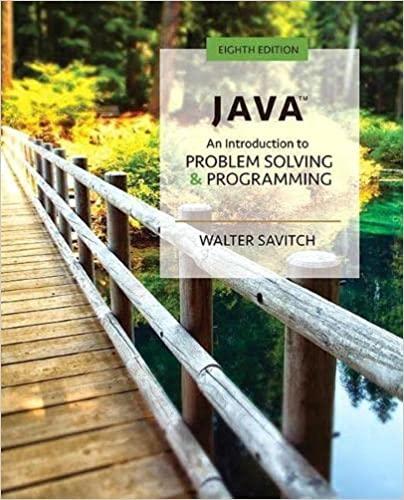The class StringLinkedListWithIterator (Listing 12.9) is its own iterator, but it does not quite implement the Java
Question:
The class StringLinkedListWithIterator (Listing 12.9) is its own iterator, but it does not quite implement the Java Iterator interface. Redefine the class StringLinkedListWithIterator so that it implements the Iterator interface. This interface declares the methods next, remove, and hasNext as follows:
/**
Returns the next element on the list.
Throws a NoSuchElementException if there is
no next element to return.
*/
public E next() throws NoSuchElementException
/**
Removes the last element that was returned most recently
by the invocation next().
i
0 1 2 3 4 5
3
6 7 8
Throws an IllegalStateException if the method next has
not yet been called or if the method remove has already
been called after the last call to the method next.
*/
public void remove() throws IllegalStateException
/**
Returns true if there is at least one more element for
the method next to return. Otherwise, returns false.
*/
public boolean hasNext()
Notice the generic data type E in the specification of the method next. If you follow the instructions in this question carefully, you do not need to know what an interface is, although knowing what one is may make you feel more comfortable. Interfaces are covered in Chapter 8.
Begin the class definition with
import java.util.Iterator;
public class StringLinkedListWithIterator2
implements Iterator
{
private ListNode head;
private ListNode current;
private ListNode previous; //follows current
private ListNodetwoBack; //follows previous
private booleanremoveSinceNext;//true if the method
//remove has been called since the last call of
//the method next. Also true if next has not
//been called at all.
public StringLinkedListWithIterator2()
{
head = null;
current = null;
previous = null;
twoBack = null;
removeSinceNext = true;
}
The rest of the definition is like the one in Listing 12.9, except that you add the method definitions specified by Iterator, make a small change to the method resetIteration so that the new instance variable twoBack is reset, and omit the methods deleteCurrentNode, goToNext, and moreToIterate, which become redundant.
- Despite its pretentious-sounding details, this exercise is fairly easy. The three method definitions you need to add are easy to implement using the methods we have.
- Note that the method hasNext and the method moreToIterate in Listing 12.9 are not exactly the same.
- The exception classes mentioned are all predefined, and you should not define them. These particular exceptions do not need to be caught or declared in a throws clause. The Iterator interface says that the method remove throws an UnsupportedOperationException remove if the method is not supported. However, your method remove has no need ever to throw this exception.
Listing 12.9
/**
Linked list with an iterator. One node is the “current node.”
Initially, the current node is the first node. It can be changed
to the next node until the iteration has moved beyond the end
of the list.
*/
public class StringLinkedListWithIterator
{
private ListNode head;
private ListNode current;
private ListNode previous;
public StringLinkedListWithIterator()
{
head = null;
current = null;
previous = null;
}
public void addANodeToStart(String addData)
{
head = new ListNode(addData, head);
if ((current == head.link) && (current != null))
//if current is at old start node
previous = head;
}
/**
Sets iterator to beginning of list.
*/
public void resetIteration()
{
current = head;
previous = null;
}
/**
Returns true if iteration is not finished.
*/
public boolean moreToIterate()
{
return current != null;
}
/**
Advances iterator to next node.
*/
public void goToNext()
{
if (current != null)
{
previous = current;
current = current.link;
}
else if (head != null)
{
System.out.println(
"Iterated too many times or uninitialized
iteration.");
System.exit(0);
}
else
{
System.out.println("Iterating with an empty list.");
System.exit(0);
}
}
/**
Returns the data at the current node.
*/
public String getDataAtCurrent()
{
String result = null;
if (current != null)
result = current.data;
else
{
System.out.println(
"Getting data when current is not at any node.");
System.exit(0);
}
return result;
}
/**
Replaces the data at the current node.
/*
public void setDataAtCurrent(String newData)
{
if (current != null)
{
current.data = newData;
}
else
{
System.out.println(
"Setting data when current is not at any node.");
System.exit(0);
}
}
/**
Inserts a new node containing newData after the current node.
The current node is the same after invocation as it is before.
Precondition: List is not empty; current node is not
beyond the entire list.
*/
public void insertNodeAfterCurrent(String newData)
{
ListNode newNode = new LisNode();
newNode.data = newData;
if (current != null)
{
newNode.link = current.link;
current.link = newNode;
}
else if (head != null)
{
System.out.println(
"Inserting when iterator is past all " +
"nodes or is not initialized.");
System.exit(0);
}
else
{
System.out.println(
"Using insertNodeAfterCurrent with empty list.";
System.exit(0);
}
}
/**
Deletes the current node. After the invocation,
the current node is either the node after the
deleted node or null if there is no next node.
*/
public void deleteCurrentNode()
{
if ((current != null) && (previous == null))
{
previous.link = current.link;
current = current.link;
}
else if ((current != null) && (previous == null))
{//At head node
head = current.link;
current = head;
}
else //current==null
{
System.out.println(
"Deleting with uninitialized current or an empty " +
"list.");
System.exit(0);
}
}
private inner class ListNode are the same as in Listing 12.7.>
}
Step by Step Answer:

Java An Introduction To Problem Solving And Programming
ISBN: 9780134462035
8th Edition
Authors: Walter Savitch





